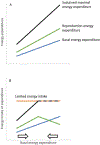Variability in energy expenditure is much greater in males than females
- PMID: 36115145
- PMCID: PMC9791915
- DOI: 10.1016/j.jhevol.2022.103229
Variability in energy expenditure is much greater in males than females
Abstract
In mammals, trait variation is often reported to be greater among males than females. However, to date, mainly only morphological traits have been studied. Energy expenditure represents the metabolic costs of multiple physical, physiological, and behavioral traits. Energy expenditure could exhibit particularly high greater male variation through a cumulative effect if those traits mostly exhibit greater male variation, or a lack of greater male variation if many of them do not. Sex differences in energy expenditure variation have been little explored. We analyzed a large database on energy expenditure in adult humans (1494 males and 3108 females) to investigate whether humans have evolved sex differences in the degree of interindividual variation in energy expenditure. We found that, even when statistically comparing males and females of the same age, height, and body composition, there is much more variation in total, activity, and basal energy expenditure among males. However, with aging, variation in total energy expenditure decreases, and because this happens more rapidly in males, the magnitude of greater male variation, though still large, is attenuated in older age groups. Considerably greater male variation in both total and activity energy expenditure could be explained by greater male variation in levels of daily activity. The considerably greater male variation in basal energy expenditure is remarkable and may be explained, at least in part, by greater male variation in the size of energy-demanding organs. If energy expenditure is a trait that is of indirect interest to females when choosing a sexual partner, this would suggest that energy expenditure is under sexual selection. However, we present a novel energetics model demonstrating that it is also possible that females have been under stabilizing selection pressure for an intermediate basal energy expenditure to maximize energy available for reproduction.
Keywords: Activity; Biological sex; DLW; Energetics; Trait variability.
Copyright © 2022 The Author(s). Published by Elsevier Ltd.. All rights reserved.
Conflict of interest statement
Conflicts of interest The authors have no conflicts of interest to declare.
Figures





References
-
- Bateman AJ, 1948. Intra-sexual selection in drosophila. Heredity 2, 349e368. - PubMed
-
- Baye A, Monseur C, 2016. Gender differences in variability and extreme scores in an international context. Large-scale Assess. Educ 4, 1.
-
- Belia S, Fidler F, Williams J, Cumming G, 2005. Researchers misunderstand confidence intervals and standard error bars. Psychol. Methods 10, 389. - PubMed

